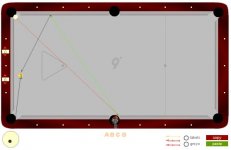DaveK said:
Any chance you will share your method with us ?
Further to your shot Regas, does anyone else play the hit by kicking off the side of the pocket you are hooked in ? Like this :
START(
%A[7\7%B[3\5%C[7\4%D[3\5%E[5\8%F[2\7%G[7\1%H[5\9%ID7Q8%J[4\7
%K[7\6%L[7\7%M[4\5%N[6\5%O[5\5%PC4C6%YD2C2%ZC9C3%[E2P6%\D4B9
%]C6[6%^D7R5%eB2a8
)END
Dave
Hmmm...that looks a lot simpler than what I did

Maybe I do look for tougher shots first.
As for my method. I am happy to share, but bear with me because it is probably hard to describe in type. I haven't even ever showed it to anybody in person, so not sure how it will come out. Here goes:
Start with the cue ball on the spot. Then aim the center of the cue ball to the center of the point. Make sure your stroke is STRAIGHT. Hit the ball with medium speed and see where it goes. Depending on the shape and hardness of the tit, it could come straight back to you or hit the opposite rail around the middle diamond or anywhere in between. Keep doing this until you can reasonably make it come back to you consistently.
Now to adjust, I think of the cue tip divided into tiny pie slices, even smaller than the hour increments on a clock would be. I turn the cue slightly to put the next 'mark' in the center of the tit, keeping the cue stick in the center of the cue ball. Then shoot it and see how much that changes the angle of the cue ball off the tit. Practice this from various cue ball positions and then when the shot comes up in play, line up straight first, and then move off of it the amount you judge that you'll need and hit it with confidence. I've found that it's easiest to control with slight draw and very slight sidespin can influence the direction of the cueball off the rail.
I've also found that it is easier to go off the tit and then into a rail to pocket a ball near a pocket than it is to go directly into the ball. I think this is because the slop in the contact with the rail tends to dampen, rather than exaggerate errors and generally create a better pocketing angle.
Anyway, I don't know if I was able to explain it very well, but next time I practice I will try to identify ways to explain it better.
Cheers,
Regas
